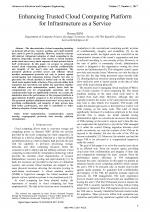| 1/2017 - 2 |
Enhancing Trusted Cloud Computing Platform for Infrastructure as a ServiceKIM, H. |
| Extra paper information in |
| Click to see author's profile in |
| Download PDF |
Author keywords
authentication, communication system security, cryptographic protocols, data security, platform virtualization
References keywords
computing(17), cloud(17), security(8), trusted(7)
Blue keywords are present in both the references section and the paper title.
About this article
Date of Publication: 2017-02-28
Volume 17, Issue 1, Year 2017, On page(s): 9 - 14
ISSN: 1582-7445, e-ISSN: 1844-7600
Digital Object Identifier: 10.4316/AECE.2017.01002
Web of Science Accession Number: 000396335900002
SCOPUS ID: 85014191578
Abstract
The characteristics of cloud computing including on-demand self-service, resource pooling, and rapid elasticity have made it grow in popularity. However, security concerns still obstruct widespread adoption of cloud computing in the industry. Especially, security risks related to virtual machine make cloud users worry about exposure of their private data in IaaS environment. In this paper, we propose an enhanced trusted cloud computing platform to provide confidentiality and integrity of the user's data and computation. The presented platform provides secure and efficient virtual machine management protocols not only to protect against eavesdropping and tampering during transfer but also to guarantee the virtual machine is hosted only on the trusted cloud nodes against inside attackers. The protocols utilize both symmetric key operations and public key operations together with efficient node authentication model, hence both the computational cost for cryptographic operations and the communication steps are significantly reduced. As a result, the simulation shows the performance of the proposed platform is approximately doubled compared to the previous platforms. The proposed platform eliminates cloud users' worry above by providing confidentiality and integrity of their private data with better performance, and thus it contributes to wider industry adoption of cloud computing. |
| References | | | Cited By |
Web of Science® Times Cited: 5 [View]
View record in Web of Science® [View]
View Related Records® [View]
Updated today
SCOPUS® Times Cited: 4
View record in SCOPUS® [Free preview]
View citations in SCOPUS® [Free preview]
[1] Data Verification of Logical Pk-Anonymization with Big Data Application and Key Generation in Cloud Computing, Kumar, Sindhe Phani, Anandan, R., Gulzar, Muhammad, Journal of Function Spaces, ISSN 2314-8888, Issue , 2022.
Digital Object Identifier: 10.1155/2022/8345536 [CrossRef]
[2] A distributed collaborative trust service recommender system for secure cloud computing, Benjula Anbu Malar, M. B., Prabhu, J., Transactions on Emerging Telecommunications Technologies, ISSN 2161-3915, Issue 12, Volume 31, 2020.
Digital Object Identifier: 10.1002/ett.3991 [CrossRef]
[3] Secured data storage in the cloud using logical Pk-Anonymization with Map Reduce methods and key generation in cloud computing, Kumar, Sindhe Phani, Anandan, R., Tchier, Fairouz, Rajchakit, G., Park, Choonkil, Tawfiq, Ferdous M. O., Journal of Taibah University for Science, ISSN 1658-3655, Issue 1, Volume 15, 2021.
Digital Object Identifier: 10.1080/16583655.2021.2001938 [CrossRef]
[4] Enhancing Cloud-Based IoT Security Through Trustworthy Cloud Service: An Integration of Security and Reputation Approach, Li, Xiang, Wang, Qixu, Lan, Xiao, Chen, Xingshu, Zhang, Ning, Chen, Dajiang, IEEE Access, ISSN 2169-3536, Issue , 2019.
Digital Object Identifier: 10.1109/ACCESS.2018.2890432 [CrossRef]
Disclaimer: All information displayed above was retrieved by using remote connections to respective databases. For the best user experience, we update all data by using background processes, and use caches in order to reduce the load on the servers we retrieve the information from. As we have no control on the availability of the database servers and sometimes the Internet connectivity may be affected, we do not guarantee the information is correct or complete. For the most accurate data, please always consult the database sites directly. Some external links require authentication or an institutional subscription.
Web of Science® is a registered trademark of Clarivate Analytics, Scopus® is a registered trademark of Elsevier B.V., other product names, company names, brand names, trademarks and logos are the property of their respective owners.
Faculty of Electrical Engineering and Computer Science
Stefan cel Mare University of Suceava, Romania
All rights reserved: Advances in Electrical and Computer Engineering is a registered trademark of the Stefan cel Mare University of Suceava. No part of this publication may be reproduced, stored in a retrieval system, photocopied, recorded or archived, without the written permission from the Editor. When authors submit their papers for publication, they agree that the copyright for their article be transferred to the Faculty of Electrical Engineering and Computer Science, Stefan cel Mare University of Suceava, Romania, if and only if the articles are accepted for publication. The copyright covers the exclusive rights to reproduce and distribute the article, including reprints and translations.
Permission for other use: The copyright owner's consent does not extend to copying for general distribution, for promotion, for creating new works, or for resale. Specific written permission must be obtained from the Editor for such copying. Direct linking to files hosted on this website is strictly prohibited.
Disclaimer: Whilst every effort is made by the publishers and editorial board to see that no inaccurate or misleading data, opinions or statements appear in this journal, they wish to make it clear that all information and opinions formulated in the articles, as well as linguistic accuracy, are the sole responsibility of the author.





